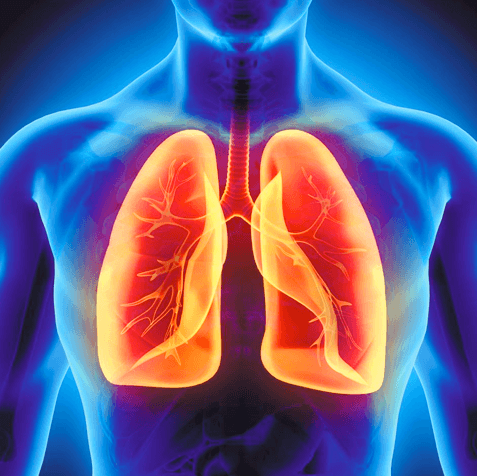
Lung disease is a condition that affects millions of people worldwide. It is one of the most common disorders experienced by people in the United States. The lungs have the crucial role of bringing in oxygen and dispelling carbon dioxide, so lung disease can potentially affect your entire wellbeing. While most people who suffer from lung disease are older, people of all ages can be impacted.
Chronic lung disease can be caused by genetics and other factors, but it is most common among individuals who are either active smokers or those who were heavy smokers for many years. The key to treating lung disease is to detect it early on and to work with your doctor to find a solution that is right for you.
Different Types of Lung Disease
Several types of lung disease can affect the delicate respiratory system. With the help of a low-dose lung CT scan, doctors get a clear picture of your lungs to spot the disorder you’re experiencing and the best way to go about treating it.
The first type of disease affects the airway or the windpipe. These thin, delicate branch-like tubes extend into the lungs to help with oxygen conversion. Some of the most common disorders that affect the airways include:
- Asthma
- COPD
- Chronic bronchitis
- Pulmonary fibrosis
- Emphysema
Other types of disease affect the air sacs, or alveoli, of the lungs, which are the small clusters of air sacs at the end of the bronchial tubes. Some of the most common conditions that impact these areas include:
- Pneumonia
- Tuberculosis
- ARDS
- Lung cancer
Both lifestyle habits and other factors can contribute to these conditions, and early screenings can help identify a problem, making treatment much more effective.
What are the Common Signs and Symptoms of Lung Disease?
Lung disease can be relatively gradual and, depending on the specific type, some individuals may even be born with the condition. However, it is not uncommon for people to develop lung disease as a direct result of some external factors. One of the major issues contributing to lung disease involves smoking. For others, the disease could have been caused by working in a facility involving coal or asbestos.
Some of the most common signs and symptoms associated with lung disease include,
- Persistent cough (either dry or with phlegm)
- Chest pain
- Difficulty breathing
- Wheezing
- Pain when breathing either in or out
- Feeling as though you’re not getting enough air
- Inability to exercise or engage in strenuous activities
- Chest pressure
- Frequent respiratory infections
People who have lung disease may have all of these symptoms, just one of them or a combination. Just because you have any one of these symptoms does not automatically mean that you have lung disease or lung cancer. Only proper screening can determine if there is an issue. However, if you are experiencing any one of these symptoms, be sure to talk to your doctor and discuss the possibility of a preventative lung CT scan. When it comes to lung disease, it is better to be safe than sorry, and early detection can mean easier and more effective treatment.
What Causes Lung Disease?
There are many different things that can cause lung disease. In most cases, disease of the lungs is caused by prolonged smoking. The risk of contracting this condition varies depending on how long a person has smoked, if they’ve ever quit and if they’re still currently a heavy smoker. For this reason, it is important to work diligently to quit smoking as soon as possible. The sooner that you quit smoking, the healthier your lungs will be and the fewer problems you’ll experience over time.
Even if you’ve never been a smoker, you could still develop lung disease at some point in your life. The condition could be a result of environmental factors, like smoke, coal or exposure to asbestos. Workers who regularly did jobs with or around these materials may eventually develop lung-related problems later in life.
Some cases of lung disease, such as asthma, can affect people of all ages, even children. Likewise, someone who was around secondhand smoke a lot when they were a child or teenager may develop lung issues when they become an adult. Some people are simply more prone to developing the condition than others, so genetics also plays a role.
Tips to Help Prevent Lung Disease
There are several ways for you to prevent lung disease from developing. If you’re currently a smoker, it’s crucial to work on ways to quit for good. Some people find that quitting cold turkey has helped them, while others rely heavily on nicotine patches and gum. You may even want to talk to your doctor about which medications are available to help curb your cravings while quitting.
Another way for you to prevent lung disease from getting worse is through routine screenings. At Preventative Diagnostic Center in Las Vegas, you can be screened with a low-dose CT scan in just a few minutes, and be on your way to receiving customized treatment that is specific to your needs. While screening doesn’t help to prevent the disease altogether, it can prevent the condition from getting worse. If you have a scan done at the onset of symptoms, you could avoid the need for more extensive treatments.
Lung disease is common, but it can be detrimental to the quality of your life. If it is left untreated, it can get worse and even prove to be fatal for those who are older. Making positive lifestyle changes and having routine screenings can help to prevent the condition from getting to that point. You owe it to yourself and your loved ones to keep your lungs healthy for a long and promising future.
Sign up to our Newsletter
(We do not share your data with anybody, and only use it for its intended purpose)
